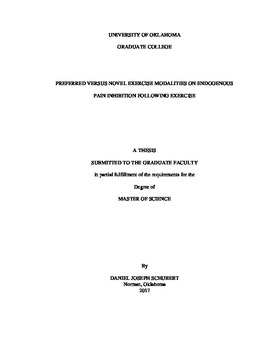| dc.description.abstract | Pain is an unpleasant sensory and emotional experience which can indicate potential or actual tissue damage. Exercise has been shown to result in marked decreases in pain sensitivity both during and following exercise. This phenomenon is termed exercise-induced hypoalgesia (EIH). While this concept has been widely observed and studied across different populations and exercise modalities, it has not been tested to observe the EIH effect of a familiar and an unfamiliar exercise modality. PURPOSE: The purpose of this study was to observe the effect of training status (highly trained using running vs. sedentary) on resting pain sensitivity to pressure stimuli and following exercise using a “familiar” modality and intensity (running) and an “unfamiliar” modality (hand-grip). METHODS: A total of 17 participants were recruited for this study, divided between 13 highly aerobically trained and 4 untrained, sedentary participants. Each participant completed 5 visits, with 2 visits of familiarization, and 3 testing visits. PPT threshold values were measured in the participant’s vastus lateralis (VL) and brachioradialis (BR) prior to, and following an isometric handgrip exercise to fatigue, a 30 minute run at 110% of gas exchange threshold (GET), and an ice bath at 2˚ Celsius. RESULTS: In the VL, baseline PPT was significantly higher (p = 0.02) in the untrained groups compared to the trained groups (909 ± 278 kPa vs. 712 ± 202 kPa). Similarly, baseline PPT in the BR was also significantly higher (p = 0.05) in the untrained group compared to the trained group (608 ± 194 kPa vs. 517 ± 147 kPa). Body weight/mass was found to be significant predictor of baseline PPT in the VL (p = 0.002) yielding an R2 value of 0.49. Body weight/mass was a significant predictor of baseline PPT in the BR (R2 = 0.51; p = 0.001). In the VL, there was not a significant group x time interaction (p = 0.43) when comparing PPT between the trained and untrained group before and after 30-min of treadmill running exercise. Nor was there a main effect for group membership(marginal means of 831 ± 258 kPa vs. 1044 ± 233 kPa for the trained and untrained groups, respectively; p = 0.19). A significant main effect for time (pre vs. post exercise) was found (p = 0.002) with VL PPT’s increasing from 812 ± 251 kPa to 929 ± 291 kPa for Pre and Post exercise, respectively. In the BR there was not a significant group x time interaction (p = 0.62) when comparing PPT between the trained and untrained group before and after 30-min of treadmill running exercise. There was a significant main effect for group membership (marginal means of 517 ± 163 kPa vs. 678 ± 254 kPa for the trained and untrained groups, respectively; p = 0.02). The main effect for time (pre vs. post exercise) was not significant (marginal means of 578 ± 250 kPa vs 618 ± 212 kPa for Pre and Post exercise, respectively; p = 0.24). In the VL, there was not a significant group x time interaction (p = 0.43) when comparing PPT between the trained and untrained group before and after 30-min of treadmill running exercise. Nor was there a main effect for group membership (marginal means of 831 ± 258 kPa vs. 1044 ± 233 kPa for the trained and untrained groups, respectively; p = 0.19). A significant main effect for time (pre vs. post exercise) was found (p = 0.002) with VL PPT’s increasing from 812 ± 251 kPa to 929 ± 291 kPa for Pre and Post exercise, respectively. In the BR there was not a significant group x time interaction (p = 0.62) when comparing PPT between the trained and untrained group before and after 30-min of treadmill running exercise. There was a significant main effect for group membership (marginal means of 517 ± 163 kPa vs. 678 ± 254 kPa for the trained and untrained groups, respectively; p = 0.02). The main effect for time (pre vs. post exercise) was not significant (marginal means of 578 ± 250 kPa vs 618 ± 212 kPa for Pre and Post exercise, respectively; p = 0.24). CONCLUSIONS: We found a significant difference between pre and post PPT thresholds in the vastus lateralis for running for 30 minutes at 110% of the participants’ GET, and isometric handgrip exercise to volitional exhaustion. Additionally, we found a significant difference between pre and post PPT in the brachioradialis following isometric handgrip exercise, but did not find a difference during the 30 minute run. | en_US |
